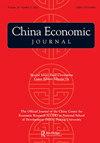The impacts of the US dollar index and the investors’ expectations on the AH Premium – a macro perspective
IF 2.3
Q1 ECONOMICS
引用次数: 3
Abstract
ABSTRACT This paper aims to provide a macro perspective to explanations of the AH premium, that is, the A and H share price differences of cross-listed companies, particularly the surge of the AH Premium Index after 2015: after the initiation of Shanghai–Hong Kong Stock Connect (SH Connect) in November 2014, the AH Premium Index jumped from 115.8 to 126.4, with a significant decline in its variance. We find that the impacts of US Dollar Index shocks dominated the overall changes in the AH premium on an individual equity basis over 2007–2019. Moreover, the US Dollar Index explains 50%-70% of the changes in the AH Premium Index, and investors’ expectations of the Chinese economy add another 10% to the explanatory power. Segregating the impact of the US Dollar Index, the average AH Premium Index only increased 2.7 percentage points, from 98.8 to 101.5. Further, after the initiation of SH Connect, the prices of cross-listed shares have been more responsive to exchange rate information. Over a longer term, SH Connect may have reduced the impacts of the US Dollar Index and increased the impacts of effective prices on equity prices. These findings demonstrate that hedging foreign exchange risks is the main reason for investment in H shares of mainland firms and, as a result, enhancing RMB foreign exchange rate flexibility is the core component as well as precondition for financial market opening in China. When market conditions permit, policy makers and regulators should consider a pilot program allowing investors to arbitrage the H shares of mainland firms with the AH premium in a reasonable range. This may further reduce the AH premium and enable the share prices to converge in the long run.美元指数和投资者预期对澳元溢价的影响——宏观视角
摘要本文旨在提供一个宏观视角来解释AH溢价,即交叉上市公司的a股和H股价格差异,特别是2015年后AH溢价指数的飙升:2014年11月沪港通开通后,AH溢价指数从115.8跃升至126.4,其方差显著下降。我们发现,2007-2009年期间,美元指数冲击的影响主导了个人股本基础上AH溢价的总体变化。此外,美元指数解释了AH溢价指数50%-70%的变化,投资者对中国经济的预期又增加了10%的解释力。除去美元指数的影响,平均AH溢价指数仅上升2.7个百分点,从98.8升至101.5。此外,沪港通启动后,交叉上市股票的价格对汇率信息的反应更大。从长远来看,沪港通可能减少了美元指数的影响,并增加了有效价格对股票价格的影响。这些发现表明,对冲外汇风险是内地企业投资H股的主要原因,因此,增强人民币汇率灵活性是中国金融市场开放的核心组成部分和前提。在市场条件允许的情况下,政策制定者和监管机构应该考虑一项试点计划,允许投资者在AH溢价合理的范围内套利大陆公司的H股。这可能会进一步降低AH溢价,并使股价从长远来看趋于一致。
本文章由计算机程序翻译,如有差异,请以英文原文为准。
求助全文
约1分钟内获得全文
求助全文

 求助内容:
求助内容: 应助结果提醒方式:
应助结果提醒方式:


